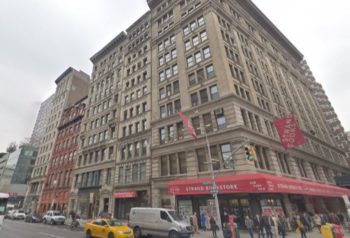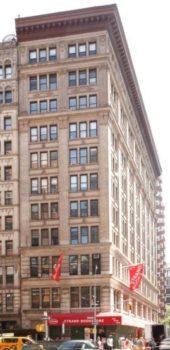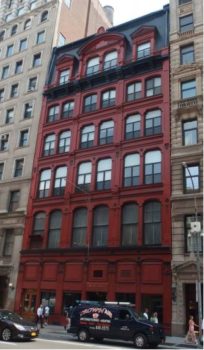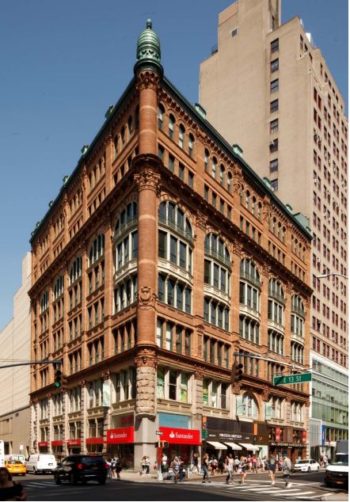
Five of the seven buildings calendared for designation. Image Credit: Google Maps
The buildings feature various architectural styles and were home to garment manufacturers in the late 19th and early 20th centuries. On September 25, 2018, the Landmarks Preservation Commission unanimously voted to add seven buildings to its calendar for consideration as individual landmarks. The buildings are located at 817 Broadway, 826 Broadway, 830 Broadway, 832 Broadway, 836 Broadway, 840 Broadway, and 841 Broadway. All of the buildings are south of Union Square in Manhattan.
The Landmarks Research Commission studied the area south of Union Square between 5th Avenue and 3rd Avenue, including where Broadway intersects the area, for historical preservation opportunities. The Landmarks Research Commission selected the seven buildings for their distinctive, intact architectural features and the importance of the buildings in Broadway’s history. The buildings were built between 1876 and 1902, a period where this area south of Union Square experienced rapid commercial development from a growing garment industry. Many of these buildings highlight innovative construction methods for this time, including the use of steel frames, electricity, and elevators. Of the seven buildings, five were built in the Renaissance Revival style.
The 817 Broadway building was constructed between 1895 and 1898 and designed by George B. Post. The building is a 14-story Renaissance Revival store and loft building. The building is on an irregular L-shaped parcel located on the southwest corner of Broadway and East 12th Street. The building features tan-colored roman brick and terracotta reliefs inspired by Italian Renaissance architecture. The building is a tripartite structure with a rusticated base, arched mid-tier, and elaborate crown with double height Corinthian columns and a pierced parapet.
The 817 Broadway building housed clothing manufacturers and became known as the Meyer Jonasson & Company Building. Meyer Jonasson & Company was one of the largest manufacturers of women garments. The building would later become known as the Sprague building and then the Anderson building. The building is currently undergoing a careful restoration of the brick and terracotta facade and an interior conversion into office and retail space.

826 Broadway. Image Credit: NYC LPC
The 826 Broadway building was constructed in 1902. The building was designed by William H. Birkmire and developed by the National Realty Company. The building is an eleven-story Renaissance Revival store and loft building. The building is architecturally significant for its still intact facade and steel frame construction. The first three stories are clad in limestone. The upper stories are clad in brick with limestone and terracotta details and are topped with a projecting metal cornice at the roof. The building was known as the National building, for the National Realty Company. The early tenants of 826 Broadway included a suit and dress manufacturer and a ribbon factory. The upper floors now contain office space. Since 1957, the Strand Bookstore occupies the street level, retail space and remains there to this day.
The 830 Broadway building was constructed between 1897 and 1898 for Ferdinand H. Mela. The building is a Renaissance Revival style store and loft building designed by Cleverdon & Putzel. The building features a tripartite facade with three stories decorated with a Classical style terracotta ornament. The middle stories have terracotta keystones topped with a two-story heavily ornamented crown. The building was originally home to garment manufacturers but eventually included small toy manufacturers. In the 1970’s, artists converted the building to a live and workspace. The 830 Broadway building shares a lot with 832 Broadway.
The 832 Broadway building was constructed between 1896 and 1897 and designed by Ralph Townsend for the Commercial Realty Improvement Company. In addition to the Renaissance Revival style, the building features many Neo-Classical details. The building has ten floors. The 832 Broadway building has a rusticated base with a heavily ornamented mid-section, ionic borders around the upper levels, and deep projecting bracketed corners on top.
In 1898, an agreement to end a clothes makers’ strike of several hundred workers was reached at 832 Broadway. In the 1930’s, the building was home to beauty and clothing companies. In the 1940’s, the 832 Broadway building held a publishing office for the Worker’s Party of America, which would later become the Communist Party of the U.S.A. Notably, the building’s location is one block south of Union Square, the location of frequent demonstrations for the Communist Party and workers’ rights. In the 1980’s, the building was converted to residential co-op apartments that are still there today.

836 Broadway. Image Credit: NYC LPC
The 836 Broadway building was constructed in 1876. Before its construction, the site was the location of the home of James J. Roosevelt, a former New York Supreme Court judge, former U.S. District Attorney, and great-uncle to President Theodore Roosevelt. When James J. Roosevelt died in 1875, his estate demolished the home and 836 Broadway constructed the current 836 Broadway building in its place. Stephen Decatur Hatch designed the building as a Second Empire/NeoGrec style cast iron front building. The building has two facades, a red painted facade on Broadway and a gray painted facade on East 13th Street. The building has a mansard roof with curved and triangular pedimented dormer windows.
The 836 Broadway building highlights the shift from a residential to a commercial neighborhood. The original tenant was Mitchell, Vance & Co., a metalwork company that specialized in lighting fixtures, clocks, and ornamental work. The building continues to function as a showroom and office space. An antique shop occupies the lower two floors, and New York University operates on the remaining floors.
The 840 Broadway building was constructed in 1899 for Henry Corn. Robert Maynicke designed the building in the Renaissance Revival style. The building is located on the southeastern corner of Broadway and East 13th Street. The tripartite facade has a limestone base and double height columns. There is elaborate terracotta detail around some of the windows and projected windows with rounded corners along both facades on the ground level. Many clothing makers, as well as the Goodyear Rubber Corporation, occupied the building in the mid-20th Century. The building was converted to co-op apartments in the 1970s.
The 841 Broadway building was constructed between 1893 and 1894 for the Roosevelt family and known as the Roosevelt building. It is located on the northwest corner of Broadway and East 13th Street. Stephen Decatur Hatch designed the building in the Romanesque Revival style. The building has eight stories and a tripartite configuration with a two-story rusticated granite base roman and upper floors with brick and terracotta ornamentation. A column topped with a copper cupola anchors the building. In 2007, a major restoration project was completed.

841 Broadway. Image Credit: NYC LPC
The 841 Broadway building is historically significant because it featured one of America’s first film studios, the American Mutoscope, and Biograph Company, later renamed the Biograph Company. In 1894, the Biograph Company manufactured the mutoscope, a single view film rolodex that operated like a flipbook. The mutoscope was an improved version of Thomas Edison’s kinetoscope. The company also created the biograph projector, which allowed for higher quality images. The Biograph Company’s first film studio operated on the roof of 841 Broadway.
During the calendar hearing, Commissioner Frederick Bland said that the 841 Broadway building highlighted a “concise history of late 19th-century commercial architecture in one block.”
The Commission considered the buildings separately. The Commissioners praised the owners of the buildings for maintaining the historic facades. The Commission unanimously approved to calendar all seven buildings.
Landmarks will hold public hearings on the designation of the seven buildings at a later date.
LPC: 817 Broadway, Manhattan (LP-2614); 826 Broadway, Manhattan (LP-2615); 830 Broadway, Manhattan (LP-2616); 832 Broadway, Manhattan (LP-2617); 836 Broadway, Manhattan (LP-2618); 840 Broadway, Manhattan (LP-2619); 841 Broadway, Manhattan (LP-2620).
By: Veronica Rose (Veronica is the CityLaw Fellow and a New York Law School Graduate, Class of 2018.)

